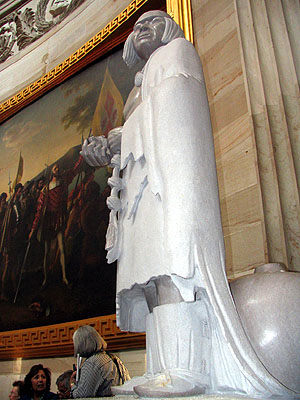

STATUE: Po'Pay is unveiled in the U.S. Capitol.

ARTIST: Cliff Fragua of Jemez Pueblo.
|
The leader of the first American revolution took his place in the U.S. Capitol on Thursday, completing a decades-long quest to recognize the enduring spirit of the Pueblo people.
In the last ceremony of its kind, the state of New Mexico installed a statue of Po'Pay in the National Statuary Hall. Tribal, state and national leaders hailed the achievements of a man whose role in the Pueblo Revolt of 1680 preserved the Pueblo way of life for future generations.
"Had it not been for that, I couldn't stand here and speak my language," said Joe Garcia, the governor of San Juan Pueblo, where Po'Pay lived.
The statue is the 100th, and final, to be placed in the
hall. Each state is allowed to install two statues to
represent notable people in their history.
As a religious man who rose up against oppression,
Po'Pay played an extremely important role in shaping
New Mexico's history, said Sen. Pete Domenici (R-New Mexico),
who led yesterday's one-hour ceremony.
"The revolt taught us an enduring lesson of tolerance and acceptance,"
he said.
"It is this lesson that has resulted in New Mexico having one
of the best, and richest multi-cultural societies in the United States,"
he added.
The idea for the statue was born in 1976, when a delegation
of Pueblo people came to Washington for the bicentennial of
the American Revolution.
While touring the Capitol grounds, they noticed
the state only had one representative in the hall -- that of
the late Dennis Chavez, the first Hispanic to serve
in the U.S. Senate -- and began a campaign to have Po'Pay
join the collection.
With the support of tribes and the state Legislature, Po'Pay finally completed the journey almost three decades later. Benny Shendo, New Mexico's secretary for Indian Affairs, said the statue highlights the state's unique cultural history.
"It was a revolt that helped shaped the evolution and character of an entire region of our country,
and it led to the survival of a culture rich in history and heritage that would one day co-exist with modern American life," said Shendo, who spoke on behalf of Gov. Bill Richardson (D), who was unable to attend the ceremony.
The seven-foot statue is not the only Native American in the hall. Sarah Winnemucca, a Paiute woman who urged friendly relations between Indians and non-Indians, represents Nevada. Eastern Shoshone Chief Washakie, who signed an historic treaty, is one of Wyoming's statues.
Sakakawea, the Shoshone woman who aided the Lewis and expedition, represents North Dakota. Will Rogers, the famed Cherokee humorist, and Sequoyah, who developed the Cherokee writing system, are Oklahoma's two statues.
But Po'Pay is the first, and only, statue to be carved by a Native American. Cliff Fragua, from Jemez Pueblo, was chosen by the New Mexico Statuary Hall Commission to create a likeness of the revolt leader out of Tennessee marble.
"He is a symbol of Native people's right to self-determination and a symbol of the desire of all people everywhere to live in freedom," Sen. Richard Durbin (D-Illinois) said of Po'Pay.
The Pueblo Revolt began on August 10, 1680, after five years of planning by Po'Pay and other leaders in Taos Pueblo. Since the tribes lacked a common or written language, Po'Pay sent runners to each village with a knotted cord that would signal the start of the attack.
The tribes succeeded in expelling the Spanish government out of Santa
Fe, the capital of the Spanish territory.
Although the Spanish returned 12 years later, the King of Spain
recognized Pueblo sovereignty and set aside land grants for
the tribes.
"By holding onto the memory of Po'Pay, America's first revolutionary,
and the memories of the other great men and women enshrined here,
we remind ourselves that our nation has been profoundly shaped by
individual acts of innovation, defiance, courage, and revolution,"
said Rep. Nancy Pelosi (D-California), the House Democratic leader.
"And we also celebrate the better America these acts have helped define."
The leaders of all 19 Pueblos in New Mexico, along with
the Hopi Tribe of Arizona and the Tigua Tribe of Texas,
who also participated in the revolt, attended the ceremony.
A dance group from San Juan Pueblo performed the Buffalo
Dance at the close of the ceremony after a blessing in
the Tewa language by Garcia. Po'Pay means "ripe pumpkin"
in Tewa.
Representatives of the Navajo Nation, New Mexico's two Apache
tribes and the Ute Mountain Ute Tribe of Colorado
were also in attendance.
Relevant Links:
Cliff Fragua -
http://www.singingstonestudio.comNational
Statuary Hall Collection -
http://www.aoc.gov/cc/art/nshNational
Statuary Hall Gallery -
http://www.virtualology.com/hallofusa/nationalstatuaryhall



